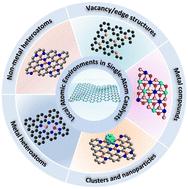碳基单原子催化剂的原子水平环境工程:氢演化和三碘化物还原的理论见解综述
IF 9.5
2区 材料科学
Q1 CHEMISTRY, PHYSICAL
引用次数: 0
摘要
碳基材料由于其可调的原子尺度微环境、优越的导电性和独特的电荷转移特性,已成为设计单原子催化剂(SACs)的理想平台。这些原子水平环境的精确工程在决定碳基sac的电子结构和催化性能方面起着至关重要的作用。然而,控制单原子键构型的基本机制及其对催化反应性的影响仍未被探索。本文系统总结了近年来通过缺陷工程、杂原子掺杂、金属-金属相互作用、纳米团簇效应和定制配位化合物设计来调节SAC活性的理论进展。通过建立稳健的结构-活性关系,我们为可持续制氢和太阳能转换的高性能sac的合理设计提供了重要的理论见解。此外,我们确定了关键挑战,并概述了未来的研究途径,以推动sac成为可持续清洁能源技术的可行解决方案。本文的综述不仅加深了对sac的基本认识,而且为开发新一代能源相关催化剂奠定了基础。本文章由计算机程序翻译,如有差异,请以英文原文为准。

Atomic-level environment engineering in carbon-based single-atom catalysts: a review of theoretical insights for hydrogen evolution and triiodide reduction
Carbon-based materials have emerged as ideal platforms for designing single-atom catalysts (SACs) owing to their tunable atomic-scale microenvironments, superior electrical conductivity, and distinctive charge-transfer properties. The precise engineering of these atomic-level environments plays a crucial role in determining both the electronic structure and catalytic performance of carbon-based SACs. However, the fundamental mechanisms governing single-atom bonding configurations and their influence on catalytic reactivity remain unexplored. This review systematically summarizes recent theoretical advances in modulating SAC activity via defect engineering, heteroatom doping, metal–metal interactions, nanocluster effects, and the design of tailored coordination compounds. By establishing robust structure–activity relationships, we provide critical theoretical insights into the rational design of high-performance SACs for sustainable hydrogen production and solar energy conversion. In addition, we identify key challenges and outline future research avenues to advance SACs as viable solutions for sustainable clean energy technologies. This review not only enhances the fundamental understanding of SACs, but also lays the foundation for the development of next-generation catalysts for energy-related applications.
求助全文
通过发布文献求助,成功后即可免费获取论文全文。
去求助
来源期刊

Journal of Materials Chemistry A
CHEMISTRY, PHYSICAL-ENERGY & FUELS
CiteScore
19.50
自引率
5.00%
发文量
1892
审稿时长
1.5 months
期刊介绍:
The Journal of Materials Chemistry A, B & C covers a wide range of high-quality studies in the field of materials chemistry, with each section focusing on specific applications of the materials studied. Journal of Materials Chemistry A emphasizes applications in energy and sustainability, including topics such as artificial photosynthesis, batteries, and fuel cells. Journal of Materials Chemistry B focuses on applications in biology and medicine, while Journal of Materials Chemistry C covers applications in optical, magnetic, and electronic devices. Example topic areas within the scope of Journal of Materials Chemistry A include catalysis, green/sustainable materials, sensors, and water treatment, among others.
 求助内容:
求助内容: 应助结果提醒方式:
应助结果提醒方式:


